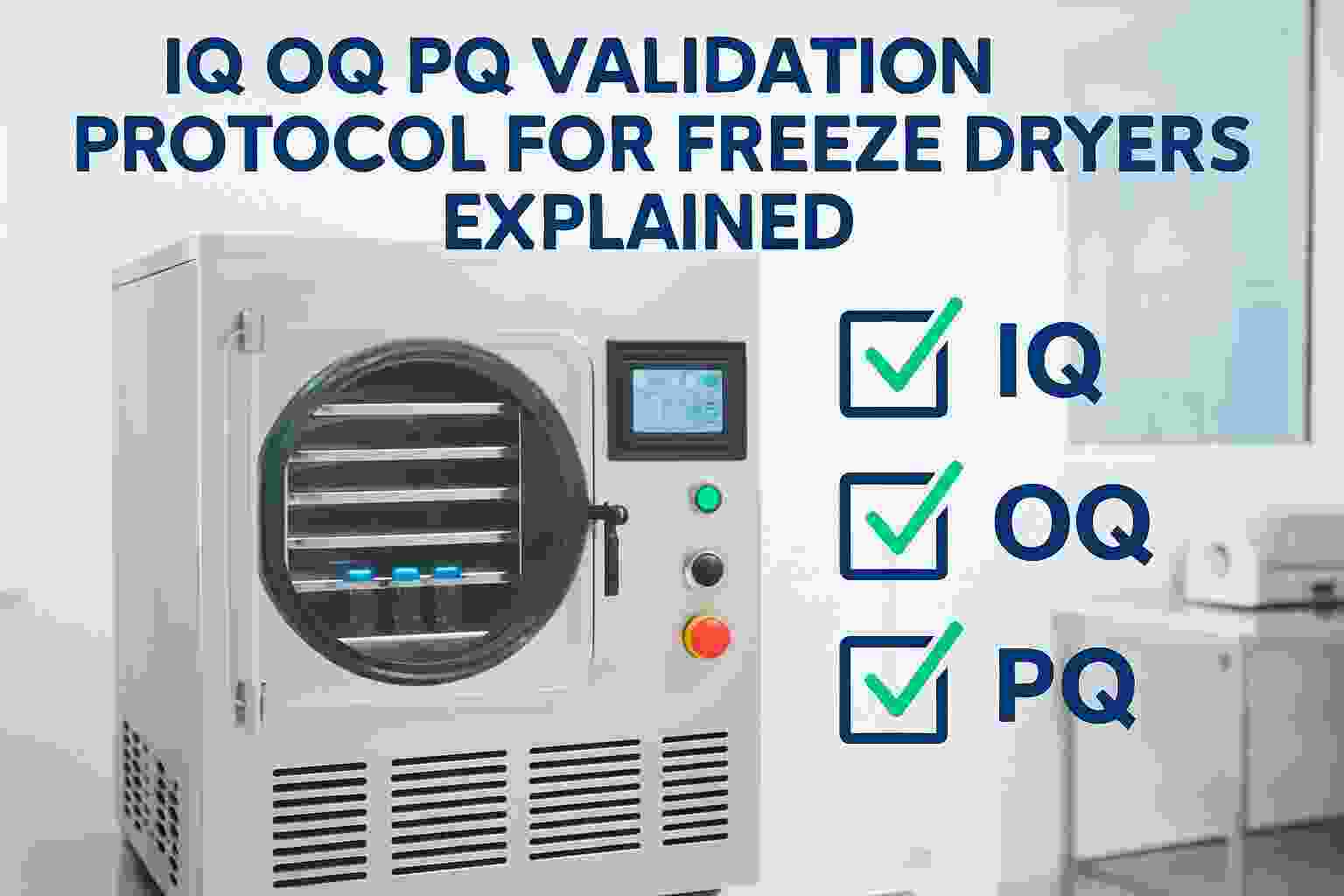When it comes to pharmaceutical manufacturing, ensuring that equipment performs as intended is non-negotiable. The IQ OQ PQ validation protocol for freeze dryers plays a pivotal role in establishing consistent performance, regulatory compliance, and safe product outcomes. This structured validation framework—Installation Qualification (IQ), Operational Qualification (OQ), and Performance Qualification (PQ)—is mandatory in regulated environments such as cGMP facilities and is particularly critical for freeze-drying applications.
✅ What Is the IQ OQ PQ Validation Protocol?
The IQ OQ PQ validation protocol is a systematic and documented process used to verify that a piece of equipment—such as a pharmaceutical freeze dryer—has been properly installed, is operating correctly, and performs consistently to produce quality products.
🔧 Installation Qualification (IQ) for Freeze Dryers
IQ ensures that the freeze dryer has been delivered and installed according to the manufacturer’s specifications and design requirements. Key activities include:
- Verifying equipment documentation (manuals, drawings, P&ID)
- Checking utility connections (power, water, air, vacuum)
- Calibration of critical instruments
- Documentation of spare parts and accessories
💡 Related Guide: Freeze Dryer Installation Check
⚙️ Operational Qualification (OQ) for Freeze Dryers
In OQ, the freeze dryer is tested to confirm that it operates within defined parameters. These tests focus on control functions, safety systems, and operating conditions. OQ includes:
- Chamber pressure and shelf temperature calibration
- Alarm functionality checks
- Verification of vacuum pump operation
- Stoppering mechanism testing
- Testing of shelf heating/cooling cycles
You may find more about this in our in-depth protocol:
👉 Freeze Dryer Operational Qualification Protocol
📈 Performance Qualification (PQ) for Freeze Dryers
PQ validates the performance of the freeze dryer under actual production conditions. This step demonstrates that the freeze dryer produces acceptable product consistently and repeatedly.
Key aspects of PQ include:
- Running multiple full-scale production cycles
- Monitoring product temperature profiles
- Verifying freeze-dried product quality (appearance, residual moisture, reconstitution time)
- Compliance with regulatory standards (e.g., FDA, EMA)
✅ Why Is IQ OQ PQ Validation Crucial in Freeze Drying?
Freeze dryers (lyophilizers) are sensitive and complex machines used to preserve temperature- and moisture-sensitive pharmaceutical products. Without proper validation:
- Batch failures may occur due to incorrect shelf temperature or vacuum level.
- Regulatory penalties could be imposed due to non-compliance.
- Product recalls might result from unvalidated performance.
🏗️ Common Challenges in Validation and How to Address Them
| Challenge | Resolution |
|---|---|
| Incomplete documentation | Create SOPs and document every qualification step |
| Instrument drift during PQ | Schedule periodic calibration and performance checks |
| Unexpected alarms during OQ | Perform root cause analysis and retest |
| Inadequate temperature mapping | Use validated thermocouples for consistent mapping |
✅ Refer to: Lyophilizer Qualification Guidelines
🔄 Best Practices for IQ OQ PQ Validation in Freeze Drying
- Conduct a risk assessment before initiating validation.
- Use traceable calibration standards.
- Prepare validation protocols and reports as per FDA 21 CFR Part 11.
- Perform re-qualification after major maintenance or upgrades.
- Involve a cross-functional team: engineering, QA, validation, and production.
🔗 Integrating Validation with Your Freeze-Drying Process
For effective results, validation should be linked with the entire process—from equipment setup to full-scale production. Enhance your approach by including:
- Media fill simulations to mimic aseptic conditions
- Leak rate testing to ensure vacuum chamber integrity
- Shelf mapping to detect hot/cold spots in load zones
Explore a detailed walkthrough on performance testing:
👉 Freeze Dryer Performance Testing Methodology
🧾 Final Thoughts
Implementing the IQ OQ PQ validation protocol for freeze dryers ensures that your lyophilization process is robust, compliant, and capable of delivering high-quality pharmaceutical products. Whether you’re installing a new unit or requalifying an existing one, following these validation steps is a regulatory and quality necessity—not just a formality.
Let your freeze drying process be backed by science, documentation, and compliance—because patient safety and product consistency start with well-validated equipment.
📌 Internal Links Used:
- https://asitafreezedryer.com/freeze-drying-unit-installation-check/
- https://asitafreezedryer.com/freeze-dryer-operational-qualification-protocol/
- https://asitafreezedryer.com/lyophilizer-qualification-guidelines/
- https://asitafreezedryer.com/freeze-dryer-performance-testing-methodology/
✅ FAQ Section
Q1. What is IQ OQ PQ validation protocol in freeze dryers?
IQ OQ PQ validation is a three-step process to ensure freeze dryers are installed correctly, operate as intended, and produce consistent product outcomes.
Q2. Why is validation important for freeze drying?
Validation ensures regulatory compliance (FDA, EMA), equipment reliability, and product quality—critical in pharmaceutical manufacturing.
Q3. When should IQ OQ PQ be performed on a lyophilizer?
It should be performed during initial installation, after major upgrades, or if any significant process deviations are observed.
Q4. How long does a complete validation protocol take?
Depending on complexity, it may take 1–3 weeks, including documentation, testing, and reporting phases.
